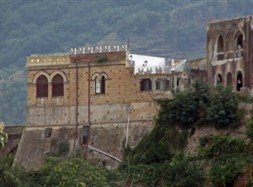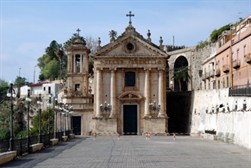The Calabria of the Ruffo: Bagnara
Calabria was undoubtedly the basis of political and economic power of the Ruffo, who almost exclusively lived and worked there until the mid-seventeenth century.
In Calabria the Ruffo had numerous fiefs – like San Lucido, Maida, Fiumara di Muro, Motta San Giovanni and Amendolea – and a feature of all of these sites is the presence of pre-existing castles (as in Bagnara), which the Ruffo acquired and restored, in many cases choosing them as temporary dwellings when they went to their lands in Calabria, and that may make for an interesting journey for tourists.
 The Ruffo Castle, adjacent to the ancient Abbey of Saint Mary and the Twelve Apostles, completely destroyed during the 1908 earthquake, is located in the upper part of the city center of Bagnara, on the promontory of Marturano, in a dominant position with respect to neighbouring buildings. It was originally the home of the castellans and the first priors of Bagnara. The castle consisted of an almost quadrangular plan on an imposing base with a counterscarp and ended in a large torus. The part which faced the sea was above the prisons. Surrounded by two levels of embrasures, among which there were canons referred to as “the twelve apostles”. The entrance was fitted with a drawbridge and the central wall which had two clocks on the southern side: one solar and the other which rang. From the pyramid of the “castellan”, a bell announced the arrival of the night, about two hours after sunset. Inside there were two luxurious apartments.
The Ruffo Castle, adjacent to the ancient Abbey of Saint Mary and the Twelve Apostles, completely destroyed during the 1908 earthquake, is located in the upper part of the city center of Bagnara, on the promontory of Marturano, in a dominant position with respect to neighbouring buildings. It was originally the home of the castellans and the first priors of Bagnara. The castle consisted of an almost quadrangular plan on an imposing base with a counterscarp and ended in a large torus. The part which faced the sea was above the prisons. Surrounded by two levels of embrasures, among which there were canons referred to as “the twelve apostles”. The entrance was fitted with a drawbridge and the central wall which had two clocks on the southern side: one solar and the other which rang. From the pyramid of the “castellan”, a bell announced the arrival of the night, about two hours after sunset. Inside there were two luxurious apartments.
The castle communicated with two outposts whose ruins are still visible; the “bastion” located to the south, and the “costanzella” to the north. The castle was certainly amended and extended by the Ruffo when they became the Dukes of Bagnara, but was destroyed by the earthquake of 1783 and was later rebuilt, probably on the ruins of the previous building, and maintains, at least externally, the appearance that it received with this reconstruction. From the second half of the eighteenth century the property of the luxurious castle were taken elsewhere by the Ruffo. The castle withstood the earthquake of 1908.
 The church of the Carmine was founded in 1687 by Carlo Ruffo, the third Duke of Bagnara Calabra, with the permission of the Dominican Fathers. It retains a testimony of the first object of worship: a Byzantine style painting, dating from around 1300, depicting the Madonna and Child. The facade, made of stone from Syracuse after the earthquake of 1908, is in a Neoclassical style, as evidenced by the four columns with Ionic-inspired capitals. It has, however, Baroque decorative elements.
The church of the Carmine was founded in 1687 by Carlo Ruffo, the third Duke of Bagnara Calabra, with the permission of the Dominican Fathers. It retains a testimony of the first object of worship: a Byzantine style painting, dating from around 1300, depicting the Madonna and Child. The facade, made of stone from Syracuse after the earthquake of 1908, is in a Neoclassical style, as evidenced by the four columns with Ionic-inspired capitals. It has, however, Baroque decorative elements.
